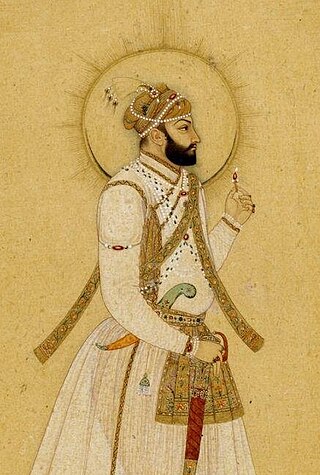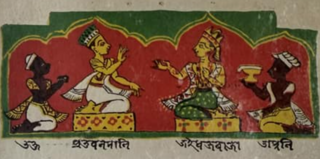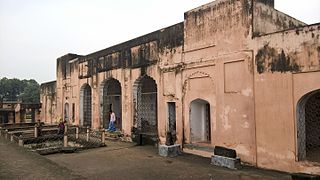
Farrukhsiyar, also spelled as Farrukh Siyar, was the tenth Mughal Emperor from 1713 to 1719. He rose to the throne after deposing his uncle Jahandar Shah. He was an emperor only in name, with all effective power in the hands of the courtier Sayyid brothers. He was born during the reign of his great-grandfather Aurangzeb, as the son of Azim-ush-Shan and Sahiba Niswan. Reportedly a handsome man who was easily swayed by his advisers, he was said to lack the ability, knowledge and character to rule independently. He was executed by Maharaja Ajit Singh of Marwar.

Mirza Shah Shuja was the second son of the Mughal Emperor Shah Jahan and Empress Mumtaz Mahal. He was the governor of Bengal and Odisha and had his capital at Dhaka, in present day Bangladesh.

The Nawab of Bengal was the hereditary ruler of Bengal Subah in Mughal India. In the early 18th-century, the Nawab of Bengal was the de facto independent ruler of the three regions of Bengal, Bihar and Orissa which constitute the modern-day sovereign country of Bangladesh and the Indian states of West Bengal, Bihar and Odisha. The Bengal Subah reached its peak during the reign of Nawab Shuja-ud-Din Muhammad Khan. They are often referred to as the Nawab of Bengal, Bihar and Orissa. The Nawabs were based in Murshidabad which was centrally located within Bengal, Bihar, and Odisha. Their chief, a former prime minister, became the first Nawab. The Nawabs continued to issue coins in the name of the Mughal Emperor, but for all practical purposes, the Nawabs governed as independent monarchs. Bengal continued to contribute the largest share of funds to the imperial treasury in Delhi. The Nawabs, backed by bankers such as the Jagat Seth, became the financial backbone of the Mughal court.

Dhaka (Dacca) is a modern megacity with origins dating to circa the 7th century CE. The history of Dhaka begins with the existence of urbanised settlements that were ruled by the Hindu Gauda Kingdom, Buddhist and Shaivite Pala Empire before passing to the control of the Hindu Sena dynasty in the 10th century CE. After the Sena dynasty, the city was ruled by the Hindu Deva Dynasty.

Mirza Abu Talib, better known as Shaista Khan, was a general and the Subahdar of Mughal Bengal, he was maternal uncle to the Mughal Emperor Aurangzeb, he acted as a key figure during his reign, Shaista Khan initially governed the Deccan, where he clashed with the Maratha ruler Shivaji, However, he was most notable for his tenure as the governor of Bengal from 1664 to 1688, Under Shaista Khan's authority, the city of Dhaka and Mughal power in the province attained its greatest heights. His achievements include constructions of notable mosques such as the Sat Gambuj Mosque and masterminding the conquest of Chittagong. Shaista Khan was also responsible for sparking the outbreak of the Anglo-Mughal War with the English East India Company.

Katra or Katara refers to a type of caravanserai, an inn or resting place, primarily found in the Bengal region. These structures were built to accommodate travellers, merchants, and their caravans.

Murshid Quli Khan, also known as Mohammad Hadi and born as Surya Narayan Mishra, was the first Nawab of Bengal, serving from 1717 to 1727.

Shuja-ud-Din Muhammad Khan was the second Nawab of Bengal, Bihar and Orissa. He married Zainab un-nisa Begum and Azmat un-nisa Begum, the daughters of Murshid Quli Khan by Nasiri Banu Begum. Shuja-ud-Din's third wife was Durdana Begum Sahiba. After the death of his father-in-law on 30 June 1727, he ascended to the Masnad (throne) of the Nawab.

Mir Jumla II, or Amir Jumla, also known as Ardistānī Mir Muhammad, was a military general, wealthy diamond trader, a Vizier of Golconda sultanate, and later a prominent subahdar of Bengal under the Mughal Emperor Aurangzeb.

The Bengal Subah, also referred to as Mughal Bengal, was the largest subdivision of Mughal India encompassing much of the Bengal region, which includes modern-day Bangladesh, the Indian state of West Bengal, and some parts of the present-day Indian states of Bihar, Jharkhand and Odisha between the 16th and 18th centuries. The state was established following the dissolution of the Bengal Sultanate, a major trading nation in the world, when the region was absorbed into the Mughal Empire. Bengal was the wealthiest region in the Indian subcontinent.

SutamlaJayadhwaj Singha was the 20th king of the Ahom kingdom. During his reign the Mughal viceroy at Bengal Mir Jumla II invaded and occupied his capital Garhgaon as a result of which he had to retreat to the Namrup area, and because of this flight he is also known as the Bhagania Roja in the Buranjis. In the days of Jayadhwaj Singha Auniati Satra and Dakhinpat Satra was established. He formally accepted the initiation of Niranjan Bapu and settled him as the as Satradhikar in the Auniati Satra. He even exempted disciples of satra from personal labour to the state.

The Battle of Khajuha was fought on January 5, 1659, between the newly crowned Mughal Emperor Aurangzeb and Shah Shuja who also declared himself Mughal Emperor in Bengal. Shuja's army rested by the tank of Khajwa, about 30 miles to the west of Fatehpur- Haswa in'the Allahabad District, between the Ganges and the Jumna.

Lalbagh anda is a fort in the old city of Dhaka, Bangladesh. Its name is derived from its neighborhood Lalbagh, which means Red Garden. The term Lalbagh refers to reddish and pinkish architecture from the Mughal period. The original fort was called Fort Aurangabad. Its construction was started by Prince Muhammad Azam Shah, who was the son of Emperor Aurangzeb and a future Mughal emperor himself. After the prince was recalled by his father, the fort's construction was overseen by Shaista Khan. The death of Shaista Khan's daughter Pari Bibi resulted in a halt to the construction process, apparently due to Shaista Khan's superstition that the fort brought bad omen. Pari Bibi was buried inside the fort.

Sonakanda Fort is a river fort situated in Narayanganj, Bangladesh, on the eastern bank of Shitalakshya River. Though the time of its establishment could not be ascertained, historians believe that the river fort was built by Mir Jumla II, a Subahdar of Bengal under the Mughal Empire, to defend Dhaka and Narayanganj from pirates.

Idrakpur Fort is a river fort situated in Munshiganj, Bangladesh. The fort was built approximately in 1660 A.D. According to a number of historians, the river fort was built by Mir Jumla II, a Subahdar of Bengal under the Mughal Empire, to establish the control of Mughal Empire in Munsiganj, and to defend Dhaka and Narayanganj from the pirates.

Mughal Tahakhana or Shah Shuja Tahakhana is a three storied building known as Tahakhana(Bengali: তাহখানা, Persian: تاهخانا ), means cold building or palace. The historical Tahakhana is located at the Gauḍa (region) in Firozpur area in the west of a big pond. It is 15 km from Chapai Nawabganj District in Shahbajpur Union at Shibganj Upazila.

The Bibi Mariam Cannon is a large early modern artillery piece on display on the grounds of the Dhaka Gate in Dhaka, Bangladesh. The cannon dates from the 17th century.

Tanda, also known as Tandah and Khwaspur Tandah, was a historic 16th-century city of Bengal in the eastern part of South Asia, and one of the most prominent medieval capitals; serving the Karrani Sultans of Bengal and the early Mughal governors of Bengal.

Mughal conquest of Chittagong refers to the conquest of Chittagong in 1666. On 27 January 1666 AD, the Arakan Kingdom of Mrauk U was defeated by the Mughal forces under the command of Buzurg Ummed Khan, the son of Mughal Subedar Shaista Khan.

The Battle of Kaliabor, also known as Battle of Kaliabar, marked a pivotal naval military confrontation between the Mughal Empire, under the command of its general Mir Jumla II, and the Ahom dynasty, led by Bargohain, on March 3, 1662, near the location known as Kaliabor, situated in modern-day Assam.























